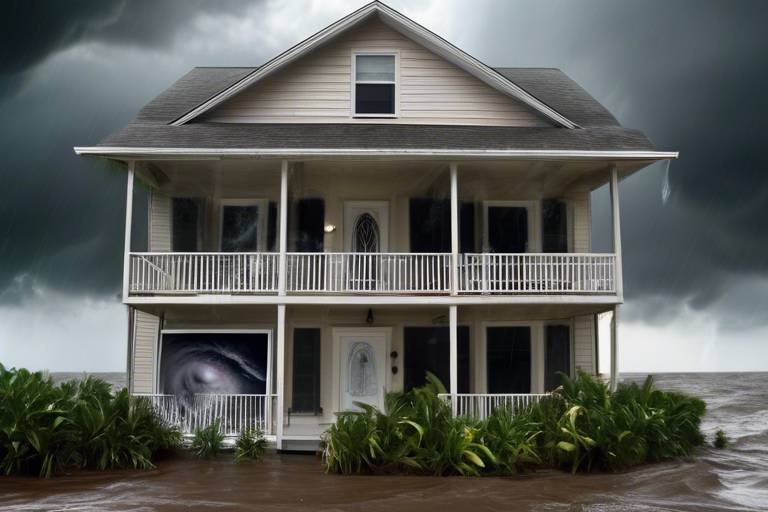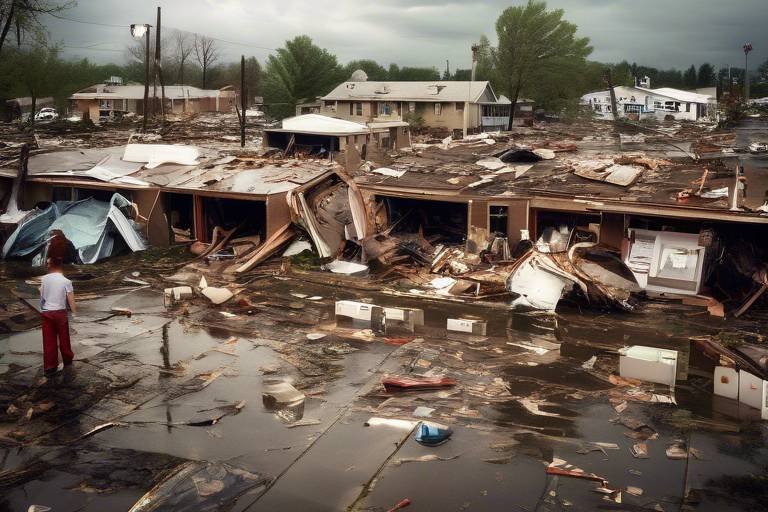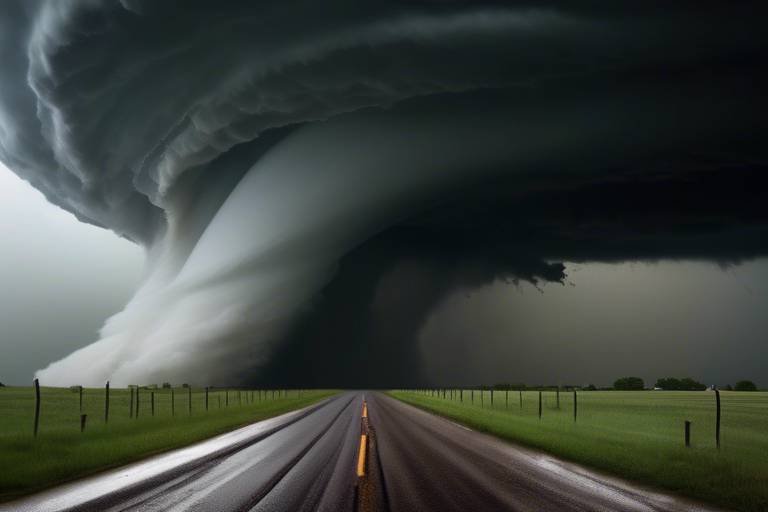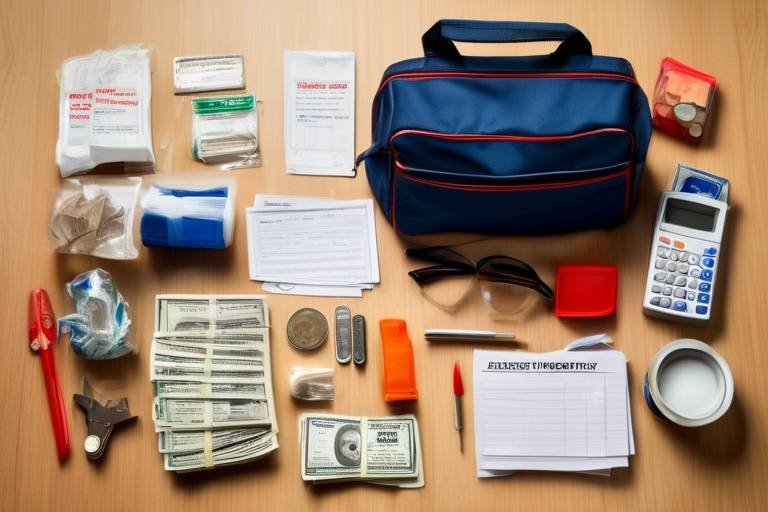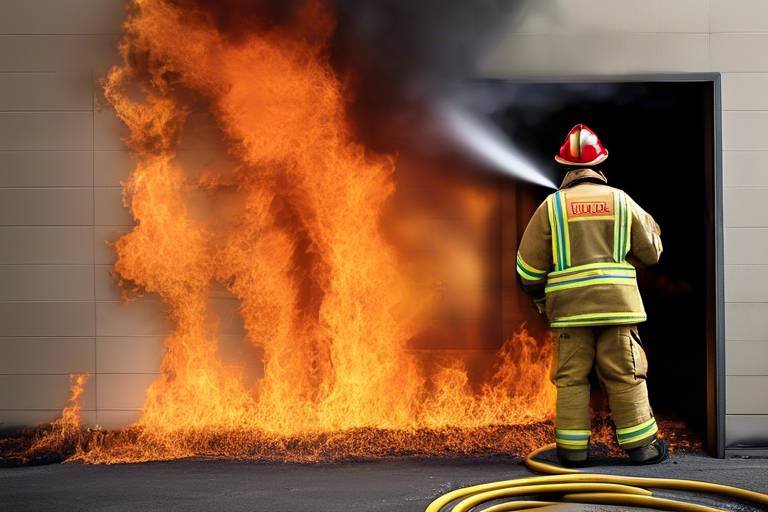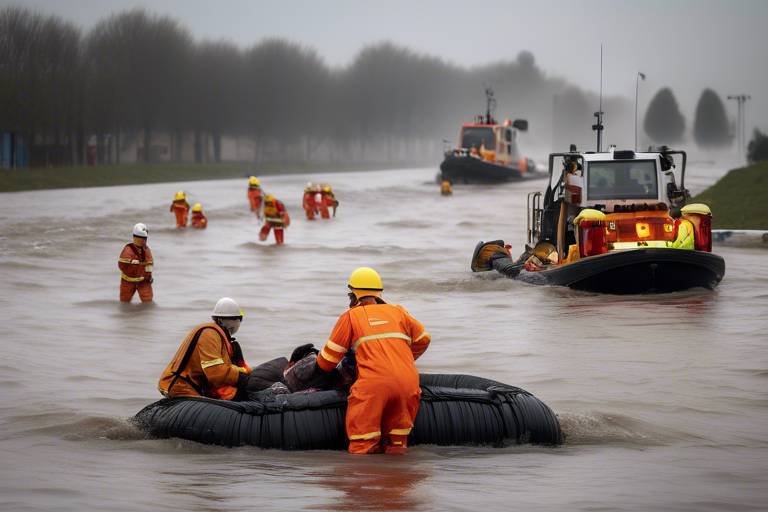Is Your House Ready for the Hurricane Season?
The hurricane season is a time of year that can bring anxiety and uncertainty for homeowners, especially those living in coastal areas. As the winds begin to howl and the skies darken, the question arises: Is your house truly prepared to face the fury of Mother Nature? It's not just about having a sturdy roof over your head; it's about ensuring every part of your home is fortified against the elements. From securing windows to creating an emergency kit, there are numerous steps you can take to safeguard your property and your loved ones.
Imagine your home as a fortress, standing strong against the storm. You wouldn't want to leave any doors unlocked or windows unbarred, would you? This article will explore essential preparations that every homeowner should undertake to protect their properties against hurricanes. By understanding the risks and assessing your home's vulnerabilities, you can make informed decisions that will minimize damage and enhance safety during the stormy season.
As we delve deeper into the intricacies of hurricane preparedness, we will cover various aspects, including:
- Understanding hurricane risks and categories
- Assessing your home's structural vulnerabilities
- Creating a comprehensive hurricane emergency kit
- Insurance considerations to protect your assets
By the end of this article, you will be equipped with the knowledge and strategies needed to ensure your home is not just a shelter but a safe haven during hurricane season. So, let’s roll up our sleeves and get started on making your house storm-ready!
Q: How can I determine if my home is at risk for hurricanes?
A: Assess your location's history with hurricanes and check local flood zone maps. Consulting with local authorities or a home inspector can also provide valuable insights.
Q: What should I prioritize when preparing for a hurricane?
A: Focus on securing your roof, windows, and doors first. Then, create an emergency kit and review your insurance policies.
Q: How often should I inspect my home for hurricane preparedness?
A: It's best to conduct a thorough inspection at least once a year, ideally before the hurricane season begins.

Understanding Hurricane Risks
Hurricanes are not just *big storms*; they are powerful natural disasters that can wreak havoc on your home and community. Understanding the risks associated with hurricanes is crucial for any homeowner, especially if you live in a hurricane-prone area. Hurricanes are categorized based on their wind speeds, and each category comes with its own set of dangers. For instance, a Category 1 hurricane might bring some strong winds and light flooding, whereas a Category 5 hurricane can unleash catastrophic winds and severe storm surges, potentially leading to total destruction.
One of the primary risks during a hurricane is **wind damage**. As the winds pick up, they can tear off roofs, shatter windows, and uproot trees. This kind of damage not only affects the exterior of your home but can also compromise its structural integrity. It’s essential to recognize that even if a hurricane is downgraded to a lower category, the winds can still be dangerous, and the aftermath can lead to unforeseen issues like water damage from leaks.
Another significant threat is **flooding**. Hurricanes often bring heavy rainfall, which can overwhelm drainage systems and lead to flash floods. Coastal areas are particularly vulnerable to storm surges, where the ocean's water level rises dramatically, inundating homes and businesses. Did you know that just a few inches of floodwater can cause thousands of dollars in damage? This is why it’s vital to assess your property’s elevation and proximity to water sources.
Here’s a quick breakdown of the different hurricane categories and their associated wind speeds:
| Category | Wind Speed (mph) | Potential Damage |
|---|---|---|
| 1 | 74-95 | Minimal damage, some roof and siding damage |
| 2 | 96-110 | Moderate damage, significant roof damage |
| 3 | 111-129 | Extensive damage, major damage to roofs and walls |
| 4 | 130-156 | Catastrophic damage, most trees will be uprooted |
| 5 | 157 or higher | Catastrophic damage, total destruction of buildings |
Being aware of these risks allows you to take proactive measures to protect your home. Consider reinforcing your roof, installing impact-resistant windows, and ensuring your property has proper drainage. Remember, preparation is your best defense against the unpredictable nature of hurricanes. Are you ready to face the storm?

Assessing Your Home's Vulnerabilities
When it comes to hurricane preparedness, understanding your home's vulnerabilities is absolutely crucial. Think of your house as a fortress; if the walls are weak, even the mightiest of defenses can crumble. So, how do you go about identifying these weak points? Start by taking a good look at your home’s structure and location. Are you situated in a flood-prone area? Do you have tall trees nearby that could fall during a storm? Each of these factors plays a significant role in your home’s overall resilience against hurricanes.
One of the primary areas to evaluate is your roof. A strong roof acts as the first line of defense against powerful winds and torrential rains. You wouldn’t want to be caught in a storm with a roof that could easily be ripped off, would you? Inspecting your roof regularly for signs of wear and tear is essential. Look for missing shingles, cracks, or any signs of water damage. If your roof is showing its age, it might be time to consider a replacement or reinforcement.
Speaking of roofs, let’s dive a bit deeper into roof integrity. Your roof should be able to withstand the harshest of conditions. High winds can lift shingles, causing leaks and further damage. To ensure your roof is up for the challenge, consider the materials used. For instance, metal roofs are often more durable than traditional asphalt shingles. They can handle high winds and are less likely to be damaged by flying debris.
When selecting roofing materials, it's essential to prioritize durability and wind resistance. Some of the best options include:
- Metal Roofing: Known for its strength and longevity, metal roofing can withstand high winds and is resistant to rust and corrosion.
- Tile Roofing: While heavier, tile roofs are incredibly durable and can endure extreme weather conditions.
- Impact-Resistant Shingles: These shingles are specifically designed to withstand hail and flying debris, making them an excellent choice for hurricane-prone areas.
Now that you know what materials to consider, it’s time to think about maintenance. Regular roof maintenance can prevent significant damage when a hurricane strikes. Make it a habit to inspect your roof at least twice a year, ideally before hurricane season. Look for any signs of damage, and don't hesitate to call in a professional if you're unsure. Keeping your gutters clean is also vital; clogged gutters can lead to water pooling and damage to your roof’s structure.
Next, let’s not forget about windows and doors. These are critical points of vulnerability that can be easily overlooked. If a hurricane hits, unprotected windows can shatter, leading to severe interior damage and posing a risk to your family. Consider installing storm shutters or using impact-resistant glass to fortify these areas. Reinforcing your doors, particularly the garage door, is equally important. A weak door can be easily blown in, compromising the safety of your entire home.
In summary, assessing your home's vulnerabilities is a proactive step in hurricane preparedness. By focusing on key areas like your roof, windows, and doors, you can significantly enhance your home’s resilience. Remember, it’s better to be over-prepared than to face the wrath of a hurricane unprotected!
Q: How often should I inspect my roof for hurricane preparedness?
A: It's advisable to inspect your roof at least twice a year, and more frequently if you live in a hurricane-prone area.
Q: What are the best materials for hurricane-resistant roofing?
A: Metal roofing, tile roofing, and impact-resistant shingles are some of the best options for hurricane-resistant roofing.
Q: How can I secure my windows against hurricanes?
A: You can secure your windows by installing storm shutters, using impact-resistant glass, or applying plywood boards if a storm is approaching.
Q: Is it necessary to reinforce my garage door?
A: Yes, reinforcing your garage door is crucial, as it can be a weak point that allows high winds to enter your home.

Roof Integrity
When it comes to hurricane preparedness, is your first line of defense. Think of your roof as the shield that protects your home from nature's fury. If it's compromised, your entire house becomes vulnerable to the relentless winds and torrential rains that accompany a hurricane. So, how do you ensure your roof is up to the task? Start by conducting a thorough inspection. Look for any signs of damage, such as missing shingles, leaks, or sagging areas. These are red flags that could spell disaster when a storm hits.
But what if your roof shows signs of wear and tear? It might be time to consider some upgrades. Certain materials can significantly enhance your roof's resilience against high winds. For instance, metal roofing is renowned for its durability and wind resistance, while asphalt shingles can also perform well if properly installed. Here’s a quick comparison of popular roofing materials:
| Material | Durability | Wind Resistance |
|---|---|---|
| Metal Roofing | 50+ years | Up to 140 mph |
| Asphalt Shingles | 20-30 years | Up to 110 mph |
| Tile Roofing | 50+ years | Up to 130 mph |
Regular maintenance is equally important. A well-maintained roof can withstand the harshest conditions. Consider scheduling a professional inspection at least once a year, or after any significant weather event. During these inspections, professionals can identify potential issues before they escalate into costly repairs. Simple practices like cleaning gutters and removing debris can also prevent water damage and ensure that your roof remains in top shape.
In summary, maintaining your roof's integrity is not just about aesthetics; it’s about protecting your home and your family. Investing time and resources into regular inspections and choosing the right materials will pay off when the storm clouds gather. Remember, a sturdy roof is your home’s best defense against hurricanes!
- How often should I inspect my roof? It's recommended to inspect your roof at least once a year and after major storms.
- What are the best materials for hurricane-resistant roofing? Metal roofing and tile roofing are among the best options for durability and wind resistance.
- Can I reinforce my existing roof? Yes, there are various methods to reinforce your roof, including adding straps and using high-quality sealants.

Choosing the Right Roofing Materials
When it comes to hurricane preparedness, selecting the right roofing materials is akin to choosing the right armor for a knight heading into battle. Your roof is the first line of defense against the fierce winds and torrential rains that hurricanes bring. Therefore, investing in durable and resilient materials can significantly reduce the risk of damage. But what should you look for? Well, let's dive deeper into the options available to you.
First and foremost, consider materials that have a proven track record of withstanding high winds. For instance, metal roofing is a popular choice due to its exceptional durability and resistance to wind uplift. Unlike traditional asphalt shingles that can easily be torn off by strong gusts, metal roofs can endure wind speeds of up to 140 mph. Additionally, metal roofs reflect heat, which can help in reducing energy costs during the hot summer months.
Another excellent option is tile roofing. Made from materials like clay or concrete, tile roofs are not only aesthetically pleasing but also incredibly robust. They can last for decades and are naturally resistant to fire, rot, and insect damage. However, it's essential to ensure that the tiles are properly installed, as poorly secured tiles can become projectiles in severe storms.
On the other hand, impact-resistant shingles are an innovation that has gained popularity in hurricane-prone areas. These shingles are designed to withstand hail and high winds, making them an excellent choice for homeowners looking for a balance between affordability and protection. They often come with warranties that last up to 50 years, providing peace of mind for many years to come.
When choosing roofing materials, you should also take into account the building codes in your area. Some regions have specific regulations that mandate the use of certain materials or installation techniques to enhance safety during hurricanes. Familiarizing yourself with these codes can help you make informed decisions and avoid potential fines or complications during the insurance claims process.
Lastly, don't forget about the importance of proper installation. Even the best materials can fail if not installed correctly. Hiring a qualified contractor who understands the nuances of hurricane-resistant roofing is crucial. They can ensure that your roof is not only aesthetically pleasing but also fortified against the elements. Remember, it’s not just about the materials; it’s about how they’re put together.
In summary, choosing the right roofing materials involves evaluating your options based on durability, resistance to wind and impact, compliance with building codes, and ensuring professional installation. By making informed choices, you can significantly enhance your home’s resilience against hurricanes, keeping your family safe and secure.

Regular Maintenance Practices
When it comes to hurricane preparedness, regular maintenance of your roof is not just a good idea—it’s a necessity. Think of your roof as the helmet of your house; it protects everything beneath it from the elements, especially during a hurricane. Regularly inspecting your roof can help you identify potential issues before they escalate into major problems. For instance, after each storm or heavy rain, take a moment to check for missing shingles, leaks, or any signs of wear and tear. This proactive approach can save you from headaches and costly repairs down the line.
Another critical aspect of roof maintenance is cleaning the gutters. Clogged gutters can lead to water pooling on your roof, which increases the risk of leaks and structural damage. Make it a habit to clear out leaves, twigs, and debris at least twice a year, or more often if you live in a heavily wooded area. You might even want to consider installing gutter guards to minimize the buildup of debris.
Additionally, you should pay attention to the flashing around chimneys, vents, and skylights. Flashing is the material that seals these areas, preventing water from infiltrating your home. Inspect it regularly for any signs of deterioration or gaps, and replace it if necessary. Remember, a small issue today can become a major problem tomorrow, especially when a hurricane is on the horizon.
Lastly, don’t underestimate the importance of professional inspections. Hiring a qualified roofer to conduct a thorough examination of your roof can provide peace of mind. They can spot issues that you might overlook and recommend necessary repairs or reinforcements. Investing in your roof’s upkeep is akin to investing in your home’s safety, especially as hurricane season approaches.
In summary, regular roof maintenance is your first line of defense against hurricane damage. By staying on top of inspections, cleaning, and repairs, you’re not just protecting your home; you’re also ensuring the safety of your loved ones. So, roll up your sleeves and start taking those essential steps today!
Q: How often should I inspect my roof for hurricane preparedness?
A: It's advisable to inspect your roof at least twice a year, especially before and after hurricane season. After severe weather events, conduct an immediate check for any damage.
Q: What are the signs that my roof needs repair?
A: Look for missing or damaged shingles, leaks inside your home, sagging areas, or visible wear around chimneys and vents. If you notice any of these, it’s time to consult a professional.
Q: Should I hire a professional for roof maintenance?
A: Yes, hiring a qualified roofer for a thorough inspection can help identify issues you may not notice. They can also provide recommendations for repairs and enhancements.
Q: How can I protect my roof from hurricane damage?
A: Regular maintenance, using durable roofing materials, and reinforcing weak spots are key strategies. Consider installing storm shutters and impact-resistant glass for added protection.

Window and Door Protection
When it comes to hurricane preparedness, windows and doors are often the most vulnerable points of your home. These openings can become entry points for destructive winds and rain if not properly secured. Imagine your home as a fortress; if the gates are weak, the enemy can easily breach your defenses. So, what can you do to fortify these critical areas?
One of the most effective ways to protect your windows and doors is by installing storm shutters. These can be made of various materials, including aluminum and plywood, and they act as a shield against flying debris. Think of them as armor for your home. Additionally, if you're looking for a more permanent solution, consider impact-resistant glass. This type of glass is specially designed to withstand high winds and flying objects, reducing the risk of breakage.
Another option is to use window film. This is a clear, adhesive film that can be applied to your existing windows, making them less likely to shatter during a storm. While it may not provide the same level of protection as storm shutters or impact-resistant glass, it can still offer an extra layer of defense. It’s like wearing a helmet; it won’t stop everything, but it can certainly help in a pinch.
Don't forget about your doors! A sturdy door is essential for keeping the storm outside. Ensure that your exterior doors are made of solid wood or metal and have a deadbolt lock for added security. You can also reinforce your door frames with metal brackets to prevent them from being blown in. Think of your door as the main entrance to your castle; it needs to be robust enough to withstand any siege.
Lastly, consider adding weather stripping around your windows and doors. This simple addition can help seal any gaps that might allow wind and water to enter your home. It’s like putting on a raincoat; it keeps the wet stuff out and helps you stay dry. By taking these steps, you can significantly reduce the risk of water damage and structural issues during a hurricane.
In summary, protecting your windows and doors is a crucial part of hurricane preparedness. By investing in storm shutters, impact-resistant glass, and reinforcing your doors, you can create a safer environment for you and your family. Remember, it’s better to be proactive than reactive when it comes to the safety of your home.
- What are storm shutters? Storm shutters are protective coverings installed over windows to shield them from high winds and debris during a hurricane.
- How effective is impact-resistant glass? Impact-resistant glass is designed to withstand high winds and flying debris, making it a reliable option for hurricane protection.
- Can I use plywood as a temporary solution? Yes, plywood can be used as a temporary measure to cover windows and doors, but it should be secured properly to withstand strong winds.
- What is weather stripping? Weather stripping is a material used to seal gaps around windows and doors, helping to prevent wind and water from entering your home.

Creating a Hurricane Emergency Kit
When the winds start to howl and the skies turn ominous, the last thing you want is to be scrambling for supplies. is not just a good idea; it's essential for ensuring your family's safety during a storm. Imagine this: the power goes out, the roads are flooded, and you can’t find your flashlight. Sounds stressful, right? That’s why preparation is key! A well-stocked emergency kit can make all the difference when the storm hits.
Your hurricane emergency kit should be tailored to your family's specific needs, but there are some must-have items that everyone should include. Start with the basics: food and water. Experts recommend having at least one gallon of water per person per day for at least three days, along with non-perishable food items that can sustain you during an extended power outage. Think canned goods, energy bars, and dried fruits. Don’t forget a manual can opener if your food needs it!
In addition to food and water, consider including a first aid kit, which is crucial for treating minor injuries that might occur during the chaos. You might also want to add essential medications and any special items for children or elderly family members. Don’t overlook personal hygiene products, as maintaining cleanliness can prevent infections, especially in emergency situations.
Another important aspect of your emergency kit is communication and information. A battery-powered or hand-crank radio can keep you updated on weather alerts and emergency information when the power is out. Make sure to include a fully charged power bank for your mobile devices, as well as a list of emergency contacts. In a world of chaos, knowing who to call can provide peace of mind.
Lastly, consider your pets. If you have furry family members, don’t forget to pack supplies for them as well. This includes food, water, and any medications they might need. After all, they rely on you for their safety too!
To help you visualize what your hurricane emergency kit might look like, here’s a simple table outlining some essential supplies:
| Essential Item | Quantity |
|---|---|
| Water | 1 gallon per person per day (for at least 3 days) |
| Non-perishable food | At least a 3-day supply |
| First aid kit | 1 kit |
| Battery-powered radio | 1 |
| Flashlight | 1 per person |
| Extra batteries | As needed |
| Medications | At least a 7-day supply |
| Pet supplies | Food, water, and medications for pets |
In conclusion, assembling a hurricane emergency kit might seem like a daunting task, but breaking it down into manageable parts can make it easier. By having these supplies ready, you can face the hurricane season with confidence, knowing that you are prepared for whatever Mother Nature throws your way.
Q: How often should I update my hurricane emergency kit?
A: It's a good idea to review and update your emergency kit at least once a year or whenever there are changes in your family’s needs, such as new medications or dietary restrictions.
Q: What should I do with my emergency kit if I need to evacuate?
A: If you need to evacuate, take your emergency kit with you. Make sure it’s easily accessible and packed in a sturdy bag or container.
Q: Are there any specific items I should include for infants or elderly family members?
A: Yes! For infants, include formula, diapers, and wipes. For elderly family members, make sure to pack necessary medications, mobility aids, and personal hygiene items.

Essential Supplies to Include
When hurricane season rolls around, it's not just about securing your home; it's also about ensuring that you and your family are equipped to weather the storm. Having an emergency kit ready can make a significant difference in your safety and comfort during those turbulent days. So, what should you pack? Let's dive into the essentials you shouldn't overlook.
First and foremost, you'll need enough non-perishable food to last at least three days. Think of items like canned goods, energy bars, and dried fruits. These are not only easy to store but also provide the necessary calories and nutrients to keep your energy up. Don't forget to include a manual can opener—there's nothing worse than being stuck with a can of beans and no way to open it!
Next up is water. The general rule of thumb is to have at least one gallon per person per day for at least three days. Water is essential for drinking, cooking, and hygiene, so stock up! If you have pets, make sure to include enough water for them too. You wouldn’t want your furry friend to go thirsty during a crisis.
In addition to food and water, a well-rounded emergency kit should also contain a first aid kit. This should include bandages, antiseptic wipes, pain relievers, and any prescription medications you or your family members may need. Accidents can happen, especially in stressful situations, and being prepared can save you a trip to the hospital.
Don’t forget to pack some flashlights and extra batteries! Power outages are common during hurricanes, and having a reliable light source can help you navigate your home safely. Consider getting LED flashlights, as they tend to last longer and are more energy-efficient.
Lastly, keep a stash of important documents in your emergency kit. This includes insurance papers, identification, medical records, and any other critical information. You can either keep these in a waterproof container or a zip-lock bag to ensure they remain intact, even if water begins to seep in.
To summarize, here’s a quick checklist of essential supplies to include in your hurricane emergency kit:
- Non-perishable food (canned goods, energy bars, etc.)
- Water (one gallon per person per day for at least three days)
- First aid kit (bandages, antiseptic, prescription medications)
- Flashlights and extra batteries
- Important documents (insurance papers, identification, medical records)
By taking the time to gather these essential supplies, you're not just preparing for a storm; you're ensuring peace of mind for you and your loved ones. Remember, preparation is key, and a little effort now can go a long way in keeping your family safe during hurricane season.
Q: How often should I check my emergency kit?
A: It's a good idea to review your emergency kit every six months to ensure that all items are still in good condition and that any expired food or medications are replaced.
Q: Can I use tap water for my emergency kit?
A: Yes, you can use tap water, but it's advisable to store it in clean, food-grade containers. If you're unsure about the quality of your tap water during a hurricane, consider using bottled water.
Q: What if I have special medical needs?
A: If you or a family member has specific medical needs, make sure to include any necessary medications in your emergency kit. It's also wise to have a list of medical conditions and emergency contacts readily available.

Planning for Evacuation
When it comes to hurricanes, planning for evacuation is not just a good idea—it's a **necessity**. The unpredictable nature of these storms means that you might have to leave your home with little notice. So, how do you prepare for such a critical situation? First off, consider your **evacuation routes**. Familiarize yourself with the roads that lead out of your area and have a couple of alternative routes in mind. Traffic can become a nightmare during an evacuation, so knowing multiple paths can save you valuable time.
Next, it’s essential to have a **designated meeting point** for your family. In the chaos of a hurricane, it’s easy to get separated. Choose a location outside your immediate area where everyone can gather if you get split up. This could be a friend's house, a community center, or even a local park. Make sure everyone in your family knows the plan and practices it. Think of it as a **fire drill**, but for hurricanes.
Don't forget to prepare your vehicle for the journey. Keep your gas tank full, as fuel may be hard to come by during an evacuation. Also, consider putting together an **emergency car kit** that includes items like water, snacks, a first-aid kit, and a flashlight. You never know when you might be stuck in traffic or need to stop somewhere unexpectedly.
Now, let’s talk about timing. It's crucial to stay updated on weather reports and evacuation orders. Make it a habit to check local news or weather apps regularly. If an evacuation order is issued, leave as soon as possible. Delaying can put you and your family at risk. Remember, the earlier you leave, the safer you'll be. It’s like catching a wave; if you wait too long, you might miss it entirely!
Lastly, don’t underestimate the importance of **communication**. Ensure that everyone in your family has a way to reach one another, whether it’s through cell phones, walkie-talkies, or even a pre-arranged signal. In the event of a hurricane, power outages are common, so having a backup plan for communication can be a lifesaver. And hey, don’t forget to keep your important documents—like insurance papers and identification—easily accessible. Consider using a waterproof bag to protect them from any water damage.
In summary, planning for evacuation involves knowing your routes, having a family meeting point, preparing your vehicle, staying informed, and ensuring effective communication. By taking these steps, you can help ensure that your family remains safe and organized when the storm clouds roll in.
- What should I include in my emergency kit? Your emergency kit should include essentials like water, non-perishable food, a flashlight, batteries, a first-aid kit, and important documents.
- How do I know when to evacuate? Monitor local news and weather channels for evacuation orders. It's best to leave early to avoid heavy traffic and ensure safety.
- Can I stay in my home during a hurricane? This depends on the severity of the storm and your home's preparedness. Always follow local authorities' advice regarding safety.

Insurance Considerations
As hurricane season approaches, one of the most critical steps homeowners can take is to review their insurance coverage. It's not just about having a policy; it's about ensuring that your home and belongings are adequately protected against the unique threats posed by hurricanes. Many people underestimate the importance of understanding their insurance policies, which can lead to devastating consequences when disaster strikes. So, what should you look for when evaluating your insurance options?
First and foremost, it’s essential to recognize that standard homeowners' insurance policies often do not cover flood damage. This is a common misconception! Flooding is one of the most significant risks during a hurricane, and without specific flood insurance, homeowners may find themselves facing hefty repair bills without any financial support. In fact, according to the National Flood Insurance Program (NFIP), just one inch of flooding can cause over $25,000 in damage to your home. Therefore, adding flood insurance to your policy is not just a good idea; it’s a necessity.
Another vital aspect to consider is windsstorm coverage. Depending on your location, you may need additional coverage for wind damage, as some policies exclude it altogether. This is particularly relevant for homeowners in coastal areas, where high winds can wreak havoc on roofs, windows, and other structural elements. It's crucial to read the fine print and understand what is and isn’t covered in your policy.
Moreover, don’t forget to assess your deductibles. Many hurricane-related policies come with higher deductibles for wind and flood damage compared to standard deductibles. This means that in the event of a claim, you could be responsible for paying a significant amount out of pocket before your insurance kicks in. It’s wise to choose a deductible that you can realistically afford, should the worst happen.
To make the process of reviewing your insurance easier, consider creating a table to compare different policies and their coverage options. Here’s a simple example:
| Insurance Type | Coverage Details | Deductible |
|---|---|---|
| Standard Homeowners Insurance | Basic property damage, theft | $1,000 |
| Flood Insurance | Water damage from flooding | $1,500 |
| Windstorm Coverage | Damage from high winds | $2,500 |
Lastly, documenting your property is a crucial step that often gets overlooked. Take the time to create a detailed inventory of your belongings, including photos and receipts, which can be invaluable when filing insurance claims. This documentation not only helps you remember what you have but also provides proof of ownership and value, making the claims process smoother and faster.
In summary, reviewing your insurance coverage before hurricane season is essential for safeguarding your home. By understanding the types of coverage available, assessing your deductibles, and documenting your property, you can ensure that you’re well-prepared to face any challenges that come your way during this stormy season.
- What types of insurance do I need for hurricane protection?
Homeowners should consider flood insurance, windstorm coverage, and standard homeowners insurance to ensure comprehensive protection. - How can I document my property for insurance purposes?
Create an inventory list with photos and receipts of your belongings to facilitate claims in case of damage. - What should I do if my insurance claim is denied?
Review your policy details carefully, contact your insurance agent for clarification, and consider appealing the decision if you believe you are entitled to coverage.

Types of Coverage to Consider
When preparing for hurricane season, it’s crucial to understand the different types of insurance coverage available to protect your home and belongings. Not all policies are created equal, and some may leave you vulnerable in the face of a storm. So, what should you be looking for? Let’s break it down.
First off, **flood insurance** is a must-have for homeowners in hurricane-prone areas. Many standard homeowners' insurance policies do not cover flood damage, which can be devastating. Flood insurance can help cover the cost of repairs and replacement of your property if water inundates your home. It’s often provided through the National Flood Insurance Program (NFIP), and it’s wise to check if you’re in a flood zone to see if this coverage is necessary.
Next, consider **windstorm coverage**. This type of insurance specifically protects against damage caused by high winds, which can be particularly destructive during a hurricane. Depending on where you live, your standard homeowners' policy may include windstorm coverage, but it’s essential to verify this. In some cases, you may need to purchase a separate policy or an endorsement to ensure you’re fully covered.
Another important aspect is **replacement cost coverage**. This policy pays for the cost to replace your damaged property with new items of similar kind and quality, rather than just reimbursing you for the actual cash value (which factors in depreciation). This can make a significant difference in your financial recovery after a storm.
Additionally, consider **additional living expenses (ALE)** coverage. If your home becomes uninhabitable due to hurricane damage, this coverage can help pay for temporary housing and other living expenses while your home is being repaired. It’s a safety net that can provide peace of mind during a stressful time.
To help you better understand these various types of insurance, here’s a quick comparison:
| Type of Coverage | Description | Importance |
|---|---|---|
| Flood Insurance | Covers damage from flooding, often not included in standard policies. | Essential for homes in flood-prone areas. |
| Windstorm Coverage | Protects against damage from high winds. | Critical for hurricane-prone regions. |
| Replacement Cost Coverage | Reimburses the cost to replace damaged items with new ones. | Ensures adequate financial recovery. |
| Additional Living Expenses (ALE) | Covers temporary housing and living expenses during repairs. | Provides peace of mind during recovery. |
Finally, it’s wise to conduct a thorough review of your policy before hurricane season kicks in. Make sure you understand your deductibles, coverage limits, and any exclusions that may apply. Having the right coverage can be the difference between a smooth recovery and a financial disaster.
Q: Do I need flood insurance if I live in a low-risk area?
A: While you may not be required to have flood insurance, it’s still a good idea to consider it. Flooding can occur in unexpected places, and having coverage can protect you from financial loss.
Q: How can I find out if I need windstorm coverage?
A: Check with your insurance provider to see if your current policy includes windstorm coverage. If you live in a hurricane-prone area, it’s likely that you’ll need it.
Q: What should I do if I’ve experienced damage during a hurricane?
A: Document the damage with photos and contact your insurance company as soon as possible to start the claims process. Having a detailed inventory can help streamline this process.

Documenting Your Property
When it comes to hurricane preparedness, one of the most overlooked yet critical steps is . Imagine this: a storm hits, and afterward, you’re left with a chaotic scene of destruction. The last thing you want is to scramble through your belongings, trying to remember what you had and how much it was worth. That’s why taking the time to document your home can save you a lot of headaches down the line, especially when it comes to filing insurance claims.
Start by gathering important documents that prove your ownership and the value of your possessions. This includes your deed, mortgage documents, and insurance policies. Having these on hand not only makes things easier for you but also provides your insurance company with the necessary information to process your claims swiftly. To make this process smoother, consider creating a dedicated folder—either physical or digital—where all these documents can be easily accessed.
Next, you’ll want to take a comprehensive inventory of your belongings. This means going room by room and documenting everything from furniture to electronics. A simple yet effective way to do this is by using your smartphone or camera to take photos or videos of each room. Be sure to capture serial numbers and any distinguishing features of high-value items, like artwork or collectibles. This visual evidence can be invaluable during the claims process.
For a more structured approach, you can create a table to keep track of your items. Here’s a simple example of how you might organize your documentation:
| Item | Description | Value | Serial Number |
|---|---|---|---|
| Living Room Sofa | Leather, 3-seater | $1,200 | 123456789 |
| Television | 55-inch Smart TV | $800 | 987654321 |
| Artwork | Framed painting by John Doe | $2,500 | N/A |
In addition to documenting physical items, don’t forget to make a note of any renovations or improvements you’ve made to your home. This can include new roofs, remodeled kitchens, or upgraded HVAC systems. Not only do these improvements add value to your home, but they also play a significant role in your insurance coverage. Make sure to keep receipts and contracts related to these upgrades.
Lastly, consider sharing this documentation with a trusted friend or family member. In the event that you’re unable to access your home after a hurricane, having someone else who knows what you own can be a game-changer. This person can help you navigate the claims process and provide additional support during a challenging time.
In summary, documenting your property is not just a task; it’s a crucial investment in your peace of mind. By taking these steps, you’re not only preparing for the worst but also ensuring that you’re equipped to handle whatever comes your way after a hurricane. So, don’t put it off—start documenting today!
- How often should I update my property documentation? It's a good practice to update your documentation annually or after any significant purchases or renovations.
- What should I do if I lose my documentation in a hurricane? If you lose your documents, contact your local government and insurance company for guidance on how to replace them.
- Can I store my documentation digitally? Yes! Digital storage is a great way to keep your documents safe. Just ensure you have backups in multiple locations.
Frequently Asked Questions
- What should I include in my hurricane emergency kit?
Your hurricane emergency kit should have essential supplies such as non-perishable food, water (at least one gallon per person per day for three days), a flashlight, batteries, a first aid kit, necessary medications, important documents, and cash. Don’t forget to include items for pets if you have them!
- How can I assess my home's vulnerability to hurricanes?
Start by inspecting your roof, windows, and doors for any signs of weakness. Look for loose shingles, cracks in the glass, or gaps around doors. It may also be helpful to consult a professional to conduct a thorough assessment of your home's structural integrity.
- What roofing materials are best for hurricane protection?
When it comes to roofing materials, consider options like metal roofs, asphalt shingles rated for high winds, or concrete tiles. These materials are known for their durability and ability to withstand hurricane conditions, providing better protection for your home.
- How do I prepare my windows and doors for a hurricane?
Securing your windows and doors can be done by installing storm shutters or using impact-resistant glass. If those aren’t options, you can board them up with plywood. Make sure all doors are secured with strong deadbolts and consider using door braces for added protection.
- What types of insurance should I consider for hurricane protection?
It’s crucial to have homeowners insurance, but you should also look into flood insurance and windstorm coverage. These policies can help protect your property from specific hurricane-related damages that standard homeowners insurance may not cover.
- How can I document my property for insurance purposes?
Document your property by taking clear photos or videos of each room, including valuable items. Create an inventory list detailing the contents of your home, noting their value. This documentation will be invaluable for insurance claims after a disaster.
- What should I do if I need to evacuate during a hurricane?
Plan your evacuation route ahead of time and know where you will go. Keep your vehicle fueled and have a packed emergency bag ready. Stay informed through local news or weather apps to know when to leave and follow any evacuation orders from authorities.

